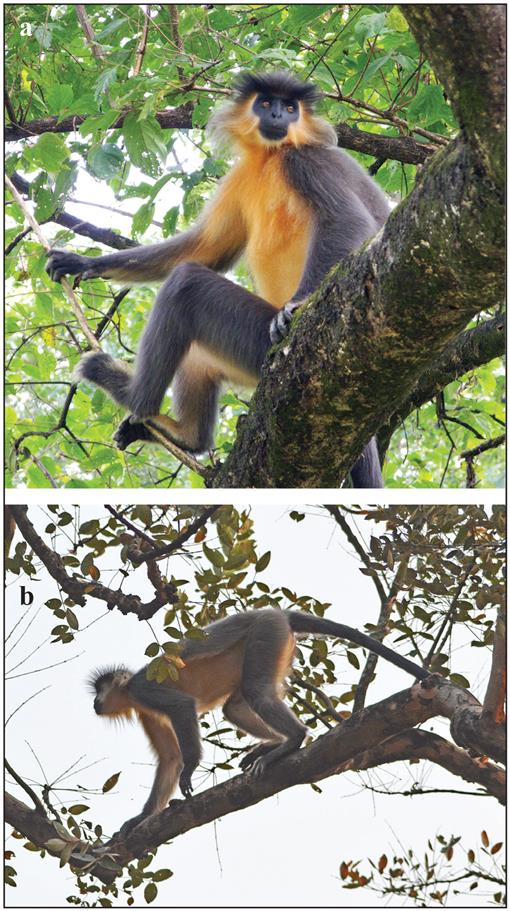Figure 1.
The past and present distribution of the capped langur, Trachypithecus pileatus, in India. Adapted from Choudhury (2013) with some changes, viz. the Jia-Bhoreli River, and the type localities of T. p. durga (Wroughton, 1916), T. p. brahma (Wroughton, 1916), T. p. tenebricus (Hinton, 1923), and T. p. saturatus (Hinton, 1923). Map drawn by Anwaruddin Choudhury.
Figure 2.
North-East India and adjacent areas of Bhutan, Bangladesh and China (Tibet) showing the ranges of the different forms in the 1950s, with museum specimen locations. For reference to the sites and specimens, see Hinton (1923) and Pocock (1928). The sites are: 1. Tura; 2. Laitkynsew; 3. Raliang, 4. Khonshnong; 5. Mokokchung; 6. Chongliyemsem; 7. Cachar; 8. Sylhet; 9. Bar Hapjan; 10. Golaghat; 11. Lakhuni; 12. Lanka; 13. Lamsakhang; 14. Motonga River; 15. Menoka Nadi; and 16. Siajuli. Map drawn by Anwaruddin Choudhury.
Table 1.
Protected areas with known populations of T. pileatus.
Table 2.
Differences between three subspecies of Trachypithecus pileatus.
Figure 3.
Variation between capped langurs north (left and center) and south (right) of the Brahmaputra River. Drawings based on individuals observed in Manas (a); Harmoty, Lakhimpur (b); Kaziranga (c and e); and Potasali, Balipara Reserved Forest, outside Nameri (d). See also the photographs. Illustrations by Anwaruddin Choudhury.
Photos 1.
Pelage color. Seasonal color variation makes pelage color redundant for the segregation of subspecies, (a) T. p. tenebricus from Manas Tiger Reserve, north of the Brahmaputra River and west of the Jia-Bhoreli River, 15 November. (b) T. p. tenebricus from Manas Tiger Reserve, 22 February. Photos by Anwaruddin Choudhury.
Photos 2.
Pelage color. Variation in color among individuals on the same day in the same group makes pelage color redundant for the segregation of subspecies. (a) T. p. pileatus from Hollongapar Gibbon Sanctuary, south of the Brahmaputra River, in May showing deep orange venter, (b) T. p. pileatus from the same group in Hollongapar Gibbon Sanctuary in May showing light orange venter. Photos by Arup Ballav Goswami.
Photos 3.
Pelage color. Color variation in a single locality showing how pelage color as a character can confuse attempts to distinguish subspecies. These photos show why the forms pileatus and durga should be considered synonyms. (a) T. p. pileatus (form durga) from Rosekandy, Cachar district, Assam, showing an unusually deep orange even on the arms and thighs, 4 June. (b) T. p. pileatus (form durga) from Rosekandy, Cachar district, Assam, showing orange whiskers and ventrum and grey arms and thighs, 4 June. (c) T. p. pileatus (form durga) from Rosekandy, Cachar district, Assam, showing a lack of any orange or reddish but uniform creamy or light yellowish whiskers and ventrum, resembling the description of the nominate form pileatus, 22 May. Photos by Khairuzzaman Mazumdar.
Photos 4.
Frontal view. Note the cap, length of the side whiskers in relation to the ears, the contact zone of the cap and forehead, and the sides of the cap (giving an appearance of horns). (a) T. p. pileatus male from Kaziranga National Park, south of the Brahmaputra River, 21 July. (b) T. p. tenebricus male from Manas National Park, north of the Brahmaputra River and west of the Jia-Bhoreli River , 15 November, (c) T. p. brahma male from Behali Reserved Forest, north of the Brahmaputra River and east of the Jia-Bhoreli River, 1 April. Photos by Anwaruddin Choudhury.
Photos 5.
Side view: Note the cap in relation to the ear. (a) T. p. pileatus from Kaziranga National Park, south of the Brahmaputra River showing the ‘army-cut’ hair-style of the cap. (b) T. p. tenebricus from Balipara Reserved Forest, north of the Brahmaputra River and west of the Jia-Bhoreli River. The location is near but outside Nameri National Park and is separated from it by the Jia-Bhoreli River. (c) T. p. brahma from Harmoty, Lakhimpur, north of the Brahmaputra and east of Jia-Bhoreli River. Photos by Anwaruddin Choudhury.
Photos 6.
Frontal, general views. (a) T. p. pileatus from Baghmara Reserved Forest, Garo Hills, south of the Brahmaputra, 30 May. Photo by Anirban Datta Roy/ Samrakshan. (b) T. p. tenebricus from Balipara Reserved Forest, north of the Brahmaputra River and west of the Jia-Bhoreli River, 21 July. Photo by Anwaruddin Choudhury. (c) T. p. brahma from Harmoty, Lakhimpur, north of the Brahmaputra River and east of the Jia-Bhoreli River, 8 April. Photo by Anwaruddin Choudhury.
Photos 7.
Frontal, general views. (a) T. p. pileatus from Inner Line Reserved Forest, Hailakandi, south of the Brahmaputra, March. (b) T. p. tenebricus from Deothang, Bhutan, north of the Brahmaputra River and west of the Jia-Bhoreli River, 30 May. (c) T. p. brahma from Mijikajan, Sonitpur, north of the Brahmaputra River and east of the Jia-Bhoreli River, September. Photos by Anwaruddin Choudhury.
Photos 8.
Frontal, general views. (a) T. p. pileatus from Dhansiri Reserved Forest, Karbi Anglong, south of the Brahmaputra River, December-January. (b) T. p. tenebricus from Sessa Orchid Sanctuary, Arunachal Pradesh, north of the Brahmaputra River and west of the Jia-Bhoreli River, May. (c) T. p. brahma from Behali Reserved Forest, Sonitpur, north of the Brahmaputra River and east of the Jia-Bhoreli River, 1 April. Photos by Anwaruddin Choudhury.
Photos 9.
More side views. (a) T. p. pileatus from Baghmara Reserved Forest, Garo Hills, south of the Brahmaputra River. Photo by Anirban Datta Roy/ Samrakshan. (b) T. p. tenebricus from Balipara Reserved Forest, north of the Brahmaputra River and west of the Jia-Bhoreli River. Photo by Anwaruddin Choudhury. (c) T. p. brahma from Behali Reserved Forest, Sonitpur, north of the Brahmaputra River and east of the Jia-Bhoreli River. Photo by Anwaruddin Choudhury.
Photos 10.
More side views. (a) T. p. pileatus in Dhaka zoo, Bangladesh, south of the Brahmaputra River. Photo by Anwaruddin Choudhury. (b) T. p. pileatus from Hollongapar Gibbon Sanctuary in May. Photo by Arup Ballav Goswami. (c) T. p. tenebricus from Manas National Park, north of the Brahmaputra River and west of the Jia-Bhoreli River. Photo by Udayan Borthakur.





















